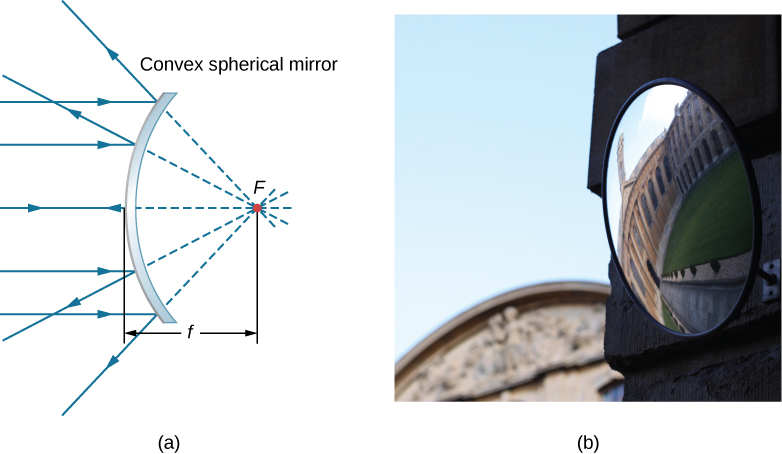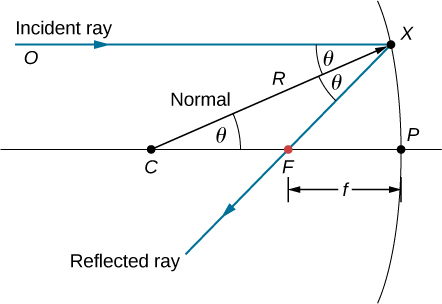| << Chapter < Page | Chapter >> Page > |
A convex spherical mirror also has a focal point, as shown in [link] . Incident rays parallel to the optical axis are reflected from the mirror and seem to originate from point F at focal length f behind the mirror. Thus, the focal point is virtual because no real rays actually pass through it; they only appear to originate from it.

How does the focal length of a mirror relate to the mirror’s radius of curvature? [link] shows a single ray that is reflected by a spherical concave mirror. The incident ray is parallel to the optical axis. The point at which the reflected ray crosses the optical axis is the focal point. Note that all incident rays that are parallel to the optical axis are reflected through the focal point—we only show one ray for simplicity. We want to find how the focal length FP (denoted by f ) relates to the radius of curvature of the mirror, R , whose length is . The law of reflection tells us that angles OXC and CXF are the same, and because the incident ray is parallel to the optical axis, angles OXC and XCP are also the same. Thus, triangle CXF is an isosceles triangle with . If the angle is small (so that ; this is called the “small-angle approximation”), then or . Inserting this into the equation for the radius R , we get

In other words, in the small-angle approximation, the focal length f of a concave spherical mirror is half of its radius of curvature, R :
In this chapter, we assume that the small-angle approximation (also called the paraxial approximation) is always valid. In this approximation, all rays are paraxial rays, which means that they make a small angle with the optical axis and are at a distance much less than the radius of curvature from the optical axis. In this case, their angles of reflection are small angles, so .
To find the location of an image formed by a spherical mirror, we first use ray tracing , which is the technique of drawing rays and using the law of reflection to determine the reflected rays (later, for lenses, we use the law of refraction to determine refracted rays). Combined with some basic geometry, we can use ray tracing to find the focal point, the image location, and other information about how a mirror manipulates light. In fact, we already used ray tracing above to locate the focal point of spherical mirrors, or the image distance of flat mirrors. To locate the image of an object, you must locate at least two points of the image. Locating each point requires drawing at least two rays from a point on the object and constructing their reflected rays. The point at which the reflected rays intersect, either in real space or in virtual space, is where the corresponding point of the image is located. To make ray tracing easier, we concentrate on four “principal” rays whose reflections are easy to construct.

Notification Switch
Would you like to follow the 'University physics volume 3' conversation and receive update notifications?